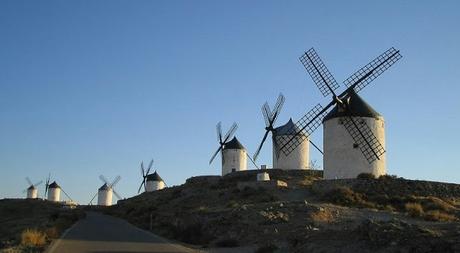Archimedes of Syracuse had already developed the screw pump that bears his name even before Jesus was a lad and those enterprising Hellenes certainly had a head start as early as the first century AD when Hero of Alexandria engineered a horizontal vaned windwheel - but its sole purpose was to make music, an early type of organ; (ah, those Greeks, ever the aesthetes).
In fact, the first utilitarian windmills didn't appear until a few centuries later around 700 - 800 AD in eastern Persia. Interestingly, they too had horizontal sails, made of bundled reeds or cloth. These early panemone mills were probably first used not for milling but for drawing up water and powering irrigation networks - as still happens today to dramatic effect on the island of Crete.

three of hundreds of windmills on Crete's Lasithi plateau
It was the Persians also who further developed the horizontal design to perform the function that earned its generic name, the milling (grinding) of grain to produce flour. This valuable technology spread east to China via the silk route and west around the Mediterranean by the end of the first millennium and shortly thereafter came the next big leap forward to a tower structure mounted with vertical vanes and sails (as seen above and below).
the vanes in Spain
These imposing tower structures, of wood, brick or stone, allowed windmills to be larger, higher, stronger and therefore much more powerful. At first their vanes were fixed, oriented to the generally prevailing wind, though this made them less effective when the wind changed direction. Therefore one further enhancement was inevitable, that which rendered the turret atop the tower to which the sails were attached capable of being rotated on the horizontal axis to face into the wind from whichever direction it chose to blow.The movement generated by the spinning of the sails was converted by a series of cogs into the rotation of a central vertical shaft which then turned the grinding or the pumping mechanism lower down in the mill.
Windmills became a common sight across Europe during the Middle Ages. Many towns in crop-growing regions had a windmill for flour production and many other areas that were either very dry (especially around the Mediterranean) or very wet (like the Netherlands on the continent or the Fens and the Fylde in England) had arrays of windmills powering pumping systems to irrigate farmland or drain polders.
Wind powered mills were used to grind not only grain but also cocoa beans, mustard seed, tobacco leaves (snuff mills anyone?) and chalk and minerals into powder for cosmetics and paint. In addition there were variations harnessing wind power to cut tree trunks into planks (saw mills, obviously enough) and to pulp wood fibres (paper mills)... and all of this using clean, green energy before a sack of fossil fuel had been hewn from the ground.
The Fylde, that low-lying coastal area of western Lancashire between the rivers Ribble and the Wyre of which Blackpool is the principal town, used to boast over thirty five windmills at one time and was even known locally as Windmill Land. Now only a handful of specimens remain, lovingly restored as popular landmarks.

Marsh Mill, one of our local survivors
As inspiration for today's poem I've gone (metaphorically) to the Netherlands, famous for its windmills, many of which still function today. I was intrigued in particular to learn how the resourceful Dutch had developed a means of signalling using the exact orientation of the sails when locked in a stationary position, + meaning open for business, x (e.g. as in the photograph above) meaning closed and other subtle gradations in between being used to signify a celebration or a warning. This sail semaphore was even used during the second world war to warn local people of impending German advances and is still in use today to mark events of national significance such as a coronation, a footballing triumph or a mourning after a major disaster.The Clog And The Jackboot
A milling wind streams steady out the west,
cresting white horses on the Zuiderzee,
the best of breezes for a working day -
yet all the country's windmills stand at rest,
sails locked in stubborn semaphore.
No grinding grains nor beans, no sawing logs
or pumping of insurgent waters
back into those linear dykes,
for there are still more pressing tasks at hand.
All in the tilt, the secret of the sails
set sinister aslant at two, five, eight, eleven
though soundless, wails as loud as any siren
for those who know the code.
The crucial message blazed from every tower
in silent geometry warns of a danger
riding tanks and shod in jackboots,
driving deadly down the road out the east,
crusading minds consumed by Aryan lore.
No mercy will be shown to gypsy or to Jew
if the advancing Hun divine their quarters;
so Dutch courage is required
to thwart a desecration on their land.
With vulnerable parties timely hidden in dusty attics
or stowed in cellars beneath piles of logs,
the intrepid locals wait for the invasion,
Dutch faces wooden as windmill sails and clogs.
Thanks for reading. Keep on turning, S ;-) Email ThisBlogThis!Share to TwitterShare to Facebook
Reactions:
